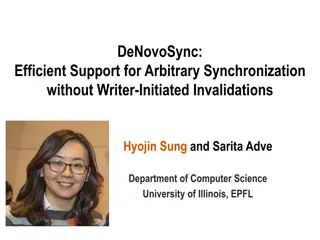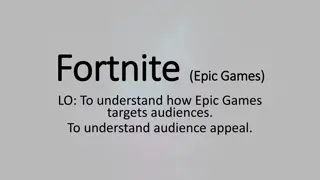Time Synchronization in Cloud Gaming Services
Cloud gaming services like AIS, TSCAI, and TSC Assistance Container play a crucial role in providing quality of service (QoS) to millions of users globally. The need for time synchronization in 5G networks, especially for industrial applications like AR/VR, is highlighted. Trusted AF entities can directly provide TSC Assistance Container and QoS requirements to the Policy Control Function (PCF), with considerations for parameters like Burst Arrival Time and Survival Time. Observations and guidelines regarding PDB determination, NEF involvement, and QoS rules are discussed in the context of different use cases. The importance of adaptive QoS management in environments with varying time domain requirements is emphasized.
Download Presentation

Please find below an Image/Link to download the presentation.
The content on the website is provided AS IS for your information and personal use only. It may not be sold, licensed, or shared on other websites without obtaining consent from the author.If you encounter any issues during the download, it is possible that the publisher has removed the file from their server.
You are allowed to download the files provided on this website for personal or commercial use, subject to the condition that they are used lawfully. All files are the property of their respective owners.
The content on the website is provided AS IS for your information and personal use only. It may not be sold, licensed, or shared on other websites without obtaining consent from the author.
E N D
Presentation Transcript
AIS, TSCAI and TSC Assistance Container Chunshan Xiong chunshxiong@tencent.com
TSC Assistance Container (PTP Time Domain) Time Domain Flow Direction Periodicity Burst Arrival time (Optional) Survival Time (Optional) TSCAI (5GS Time) Flow Direction Periodicity Burst Arrival time (Optional) Survival Time (Optional) SMF BAT in TSCAI is determined based on BAT in TSC-A-C with the time drift/rateRatio, CN-PDB and UE-DS-TT Resident Time Survival Time in TSCAI is also determined based on Survival Time in TSC-A-C with the rateRatio. Periodicity in TSCAI = Periodicity in TSC-A-C Observation 1: AF can directly create/generate the TSC Assistance Container and the SMF can determine the TSCAI based on TSC-A-C (both in the AF PCF and AF NEF Observation 2: NEF does NOT need to create/generate the TSC Assistance Container. Observation 3: The TS23.501/2/3 needs to be updated based on above observations. PCF cases).
2.NEF TSC QoS 1.AF TSC QoS 3.PCF TSC QoS Rules Requested 5GS delay, Requested GFBR, Requested MFBR, Requested PDB, Requested GFBR, Requested MFBR, Requested PDB, Requested GFBR, Requested MFBR, NEF (Untrusted AF) or PCF (Trusted AF) GFBR(1) = GFBR(2) = GFBR(3) MFBR(1) = MFBR(2) = MFBR(3) PDB(2) = PDB (3) 5GS delay(1) (UE-DS-TT Resident Time) = PDB (2 or 3) Observation 4: PDB determination is NOT related with time domain(or time synchronization) but with the architecture ( with UE-DS-TT). Observation 5: If the PCF receives the direct TSC QOS request from the AF, the PCF can determine the requested PDB based on the Requested 5GS delay and UE-DS-TT Resident Time. If there is no UE-DS-TT information, the PCF copies the PDB from the 5GS delay; Observation 6: If the PCF receives the TSC QOS request from the NEF, the PCF copy the PDB from the NEF TSC QoS Request ; Observation 7: For the AIS, normally, there is no UE-DS-TT is used for the cloud gaming/AR/VR, in such case, UE-DS-TT Resident Time=0, and the PCF can also copy the PDB from the direct AF TSC QoS Request. New CR
AIS and TSC and Time Synchronization Cloud Gaming service are widely used from 4G and cloud gaming user are greater than several hundred Million user in global. All these mobile CG users are connected to 4G and 5G without DS-TT and without time synchronization requirements. The basic assumption for the AIS is no time synchronization is required and no DS-TT is used and Trusted AF can directly provide TSC Assistance container and QoS Requirements to the PCF with the 5GS delay = PDB. It is allowed that the AIS can be provided in the time synchronized 5G network, e.g. the industrial AR/VR may need time synchronization. In such case, the Trusted AF can directly provide TSC Assistance container and QoS Requirements to the PCF and the PCF can determine the PDB = 5GS Delay ( UE-DS-TT Resident Time ). The WID of AIS focuses on the QoS-related standards. Observation 8: The basic assumption for the AIS is no time synchronization is required and no DS-TT is used. Observation 9: For the AIS, the Trusted AF can directly provide TSC Assistance container and QoS Requirements to the PCF with the 5GS Delay = PDB; Observation 10: The industrial AR/VR may need time synchronization, in such case, the Trusted AF can directly provide TSC Assistance container and QoS Requirements to the PCF and the PCF can determine the PDB = 5GS Delay ( UE-DS-TT Resident Time ).























